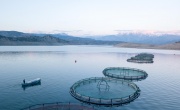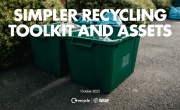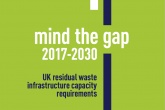Residual waste infrastructure: Heated debate continues as ESA weighs up differing arguments
The argument over the future of the UK’s residual waste treatment capacity has reopened today, after the Environmental Services Association (ESA) published a review of previous reports and reiterated the prediction that six million tonnes of residual waste will have nowhere to go in the UK by 2030.
 The debate into incineration was reignited in the summer when a series of reports estimated the disparity between waste generation and treatment infrastructure in the coming decades, carrying with them recommendations over actions to address the difference.
The debate into incineration was reignited in the summer when a series of reports estimated the disparity between waste generation and treatment infrastructure in the coming decades, carrying with them recommendations over actions to address the difference.
The reports varied hugely with projections for the state of the residual waste treatment market in 2030 ranging from an under-capacity of 10.4 million tonnes (Biffa) to an over-capacity of 9.5 million tonnes (Eunomia).
At the time the ESA welcomed calls to increase energy-from-waste capacity to address projected shortfalls saying that any reports to the contrary risks leading the government to ‘sleepwalk into a capacity crisis’, saying that it is ‘galling that [Eunomia] continues to repeat the message when we are crying out for more investment in our industry’.
Following the summer’s war of words, the ESA has today (30 November) released a briefing, along with an independent analysis of the UK waste market by Tolvik Consulting, with the stated aim of identifying areas of common ground between differing reports.
Tolvik’s ‘UK Residual Waste: 2030 Market Review’ compares the data used by the various reports - including unpublished analyses from waste firms Viridor and FCC, and consultancy SLR - to see where differences in methodology could have created these differences on outlooks. This fed into the ESA’s briefing, ‘The treatment capacity gap that urgently needs to be addressed’.
The ESA suggests, rather bleakly, that recycling rates are unlikely to rise much further above their current levels (to between 50-55 per cent), despite European targets stretching to 2030 that will likely require the UK to improve its 45 per cent overall recycling rate by around 20 percentage points. This, it estimates, would leave the UK six million tonnes short of treatment capacity by 2030, even after waste exports to the EU and facilities currently in the pre-planning phase are factored in.

It considers both of these unlikely (though in the past week the government has committed to embracing a more circular economy and developing the market for secondary materials in its Industrial Strategy), and so deigns private sector development of residual waste infrastructure to be the clearest solution for closing the ensuing waste treatment gap.
Closing this six-million-tonne capacity gap, the ESA says, would lead to £4.5 billion in capital investment, around 1,500 permanent jobs in the waste sector and almost 7,500 jobs in the construction phase, while the additional energy-from-waste capability would, it suggests, produce almost 0.5GW of electricity, capable of powering around 720,000 homes.
These findings tally with those reported by waste management firms Biffa and SUEZ in the summer, the latter of which warned of a ‘potential disaster scenario’ if the capacity shortfall is not addressed.
While the ESA’s summation is similar to that of the waste management firms, it is not a consensus view. Eunomia Research & Consulting is one party that has for a long time offered a dissenting stance: that if current trends were to continue, the UK would reach over-capacity by 2020/21, with excess capacity increasing to 9.5 million tonnes by 2030/31. According to Eunomia’s estimates, UK residual waste treatment capacity has doubled to 13.5 million tonnes since 2009/10, while the amount of residual waste suitable for treatment has fallen from 30 million tonnes per year to 26 million in the same timeframe.
Creating over-capacity would lead to energy-from-waste facilities needing to be fed material in order to operate, which Eunomia fears could result in recyclable waste being diverted to incinerators to make up the shortfall, imposing a ceiling for recycling in the UK.
Commercial assumptions
One of the issues with the debate, which has been going on for years and shows no signs of slowing down, is that much of the data needed to support or negate the necessity of developing more residual waste treatment infrastructure does not exist. While we know generally how much waste is created by municipal sources, the UK has no records of how much waste the millions of commercial and industrial (C&I) businesses based in the country produce.
As Anthesis Principal Consultant Peter Scholes wrote for Resource in October, the lack of data on this huge waste source ‘makes it difficult to formulate policy and provide a framework for viable waste management for C&I waste’.
The projected input for C&I waste is therefore based on assumptions. The Tolvik report for the ESA states that uncertainty over C&I waste arisings has been ‘further magnified’ by Defra, showing significant reductions ‘as a result of changing methodologies’, and that this trend will reverse. Eunomia, meanwhile, suggests that there is no reason for this assumption, and that ‘using a high growth rate scenario risks substantially overstating potential future waste arisings.’
Ongoing disagreement
Responding to today’s ESA report, Eunomia says that the review ‘prominently presents scenarios that bear no relation to the current, or likely future, reality’, ignoring 4.5 million tonnes of capacity that would ‘significantly alter the report’s findings’. Further, the consultancy suggests that the review under-estimates current treatment capacity in the form of mechanical biological treatment (MBT), landfill and refuse-derived fuel (RDF) exports.
These assumptions, Eunomia says, reduce the headline capacity gap by around 10 million tonnes, meaning that unless recycling rates remained pretty as much they are now, there would be no need for further capacity.
“Whilst this report has clearly tried to take on board a wide range of views, it has done little to resolve the debate in this area,” said Eunomia Principal Consultant Peter Jones. “Instead, it takes an unrealistically bullish approach to many of the key assumptions. It therefore significantly overstates the UK’s need for residual waste treatment infrastructure, thereby risking the building of more costly infrastructure than we need.

‘Stark’ conclusions require action, says industry
Waste management firms, and the ESA, which represents the industry, stands firm in its assessment, however: “The waste and recycling industry is alarmed by the emergence of a critical lack of infrastructure to treat the nation’s waste,” said ESA Executive Director Jacob Hayler. “ESA’s Members have invested around £5 billion in UK recycling and recovery facilities in the past five years and completed detailed modelling exercises to understand what further investment is required for the future.
“Their conclusions are stark: by 2030 the UK needs faces a shortfall of six million tonnes of waste treatment capacity. Without action, this means that five million UK homes will see their waste buried in landfill when it could be used to generate energy, helping to safeguard the UK’s energy supplies. We urgently need the government to recognise the waste crisis the UK is facing and give the industry the long term clarity it needs to invest in new energy from waste facilities.”
It must be noted that each of these reports has been produced by companies that stand to gain from the expansion of energy-from-waste. However, Stuart Hayward-Higham, Technical Development Director at SUEZ recycling and recovery UK, and author of its ‘Mind the Gap 2017-2030’ report said: “It is important that this is not viewed as the waste industry attempting to secure more EfW capacity than the nation needs. To the contrary, overstating the case for investment would only damage companies, like SUEZ, which continue to invest billions of private capital to provide this vital infrastructure.
“Our industry is not calling for subsidies, or to be propped up by the public purse. Our only requirement is political leadership to guide and safeguard future investment by our sector in the UK through towards 2050. This leadership is just as vital for local authorities who are setting their long term strategies and procuring major infrastructure or services.
“The capacity gap will become a capacity crisis if we eschew EfW in favour of high-reaching recycling targets without robust policy action (and associated investment) to back it up. However, it is firmly our belief that this value stream approach needs to be considered at a regional level, which may result in different outputs for different regions dependent on the region’s role within the circular economy. For example, the Northern Powerhouse and Midlands Engine already have very different treatment capacity outlooks compared with the South East and will likely have very different future resource needs.”
This doesn’t look like a debate that is going to be agreed upon any time soon.
The ESA’s briefing, ‘The treatment capacity gap that urgently needs to be addressed’, and Tolvik’s ‘UK Residual Waste: 2030 Market Review’ can both be read and downloaded on the ESA’s website. 










